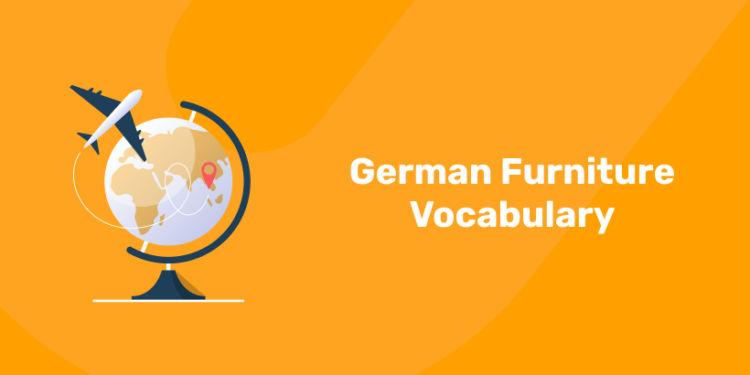Table of Contents
Introduction
Learning a new language opens up a whole new world, especially when it comes to culture and daily life. One of the key parts of any culture is the furniture – how people furnish their homes says a lot about their lifestyle, traditions and even their taste. In this blog post we’ll be looking at German furniture vocabulary, so you can impress your friends with the right words to talk about furniture in German. Whether you’re planning a trip to Germany, talking interior design or just want to expand your vocabulary, this guide will help you navigate the world of German furniture.
German Furniture Vocabulary Lists
1: How do you say "Good Morning" in German?
First let’s look at some basic furniture vocabulary in German. This will include the German word, the English translation and an example sentence.
Basic Furniture
- Tisch – Table
Ich habe einen neuen Tisch gekauft. (I bought a new table.) - Stuhl – Chair
Der Stuhl ist sehr bequem. (The chair is very comfortable.) - Sofa – Sofa/Couch
Das Sofa ist in der Ecke des Raumes. (The sofa is in the corner of the room.) - Bett – Bed
Ich gehe jetzt ins Bett. (I am going to bed now.) - Schrank – Wardrobe/Cabinet
Die Kleidung ist im Schrank. (The clothes are in the wardrobe.) - Regal – Shelf
Die Bücher stehen im Regal. (The books are on the shelf.) - Kommode – Chest of drawers
Ich habe meine Socken in die Kommode gelegt. (I put my socks in the chest of drawers.) - Tischlampe – Table lamp
Die Tischlampe ist sehr hell. (The table lamp is very bright.) - Teppich – Carpet/Rug
Der Teppich ist aus Wolle. (The carpet is made of wool.) - Vorhang – Curtain
Die Vorhänge sind blau. (The curtains are blue.)
Living Room Furniture
- Sessel – Armchair
Ich sitze gerne in meinem Sessel. (I like to sit in my armchair.) - Couchtisch – Coffee table
Der Couchtisch steht vor dem Sofa. (The coffee table is in front of the sofa.) - Fernseher – Television
Der Fernseher ist kaputt. (The television is broken.) - Regalwand – Wall shelf
Die Regalwand ist voll mit Fotos. (The wall shelf is full of photos.) - Kamin – Fireplace
Der Kamin ist im Winter sehr gemütlich. (The fireplace is very cozy in winter.)
Bedroom Furniture
- Nachttisch – Nightstand
Auf dem Nachttisch liegt ein Buch. (There is a book on the nightstand.) - Bettwäsche – Bed linen
Ich habe neue Bettwäsche gekauft. (I bought new bed linen.) - Matratze – Mattress
Die Matratze ist zu hart. (The mattress is too hard.) - Duvet – Duvet
Das Duvet hält mich warm. (The duvet keeps me warm.) - Kissen – Pillow
Ich brauche ein neues Kissen.
Kitchen Stuff
- Küchentisch – Kitchen table Example: Der Küchentisch ist aus Holz. (The kitchen table is made of wood.)
- Stühle – Chairs (plural) Example: Die Stühle sind aus Metall. (The chairs are made of metal.)
- Schränke – Cabinets (plural) Example: Die Schränke sind voll mit Geschirr. (The cabinets are full of dishes.)
- Spüle – Sink Example: Die Spüle ist sehr tief. (The sink is very deep.)
- Herd – Stove Example: Der Herd funktioniert gut. (The stove works well.)
Bathroom Stuff
- Waschbecken – Washbasin Example: Das Waschbecken ist verstopft. (The washbasin is clogged.)
- Dusche – Shower Example: Die Dusche ist sehr heiß. (The shower is very hot.)
- Badewanne – Bathtub Example: Ich nehme ein Bad in der Badewanne. (I am taking a bath in the bathtub.)
- Spiegelschrank – Medicine cabinet Example: Der Spiegelschrank hat viele Fächer. (The medicine cabinet has many shelves.)
- Toilette – Toilet Example: Die Toilette ist sauber. (The toilet is clean.)
Speak German Fluently – Your Future Starts Here!
Join our interactive German courses designed for all levels. Gain the skills to communicate effectively and open doors to new cultures and careers.
Start Learning GermanHow to remember and use German furniture vocabulary
Remembering vocabulary can be tough, but there are several ways to make it easier and more fun. Here are some tips to help you learn German furniture vocabulary:
- Flashcards: Create flashcards with the German word on one side and the English translation on the other. This is great for visual learners and can be used for any vocabulary set.
- Label Your Stuff: If you’re in a German-speaking environment or can create one at home, label your furniture with sticky notes with the German words. This will help you see it all the time.
- Apps: Language learning apps like Duolingo and Memrise can be helpful for practicing vocabulary. They use gamification to make it fun.
- Practice with Sentences: Try to use new vocabulary in sentences. This will help you remember the words and see how they fit into the language.
- Group Study: Join a language group or find a study buddy who is also learning German. Learning with someone else can be motivating.
- Surround Yourself: Watch German movies or TV shows, listen to German music or read German books. The more you surround yourself with the language, the more you’ll get to know the vocabulary.
- Review Regularly: Review the vocabulary you learned from time to time to keep it in your head. Setting aside time every week to go over old vocabulary is great.
More Resources to Learn German Vocabulary
In addition to the above tips, using multiple resources can help. Here are some:
- Online Courses: Entri has German language courses that cover vocabulary, grammar and culture. Their structured approach helps you progress faster.
Try Entri’s German Course
- YouTube Channels: There are many YouTube channels that teach German. Channels like “Learn German with Anja” or “Get Germanized” have lessons to help you learn vocabulary visually and auditorily.
- Podcasts: Listen to German podcasts like “Coffee Break German” or “Learn German by Podcast” to improve your listening and learn new vocabulary.
- Books: Buy German vocabulary books or phrasebooks that focus on specific topics like furniture or home decor. This targeted approach will give you more depth.
- Language Exchange: Join a language exchange where you can practice speaking with native German speakers. Real life practice will help you become more fluent and comfortable with vocabulary.
Conclusion
Learning German furniture vocabulary is a part of your overall language learning and cultural understanding. From basic words like “Tisch” and “Stuhl” to specific vocabulary for different rooms in the house, having this vocabulary will make your conversations and experiences more enjoyable.
As you continue to learn, consider joining a structured course that will guide and support you. Entri’s German course has a full curriculum to help you become fluent, with interactive lessons and practice with experienced teachers.
Use this vocabulary now!
Entri’s German Course!
Speak German Fluently – Your Future Starts Here!
Join our interactive German courses designed for all levels. Gain the skills to communicate effectively and open doors to new cultures and careers.
Start Learning GermanFrequently Asked Questions
What are the most common German words for basic furniture?
The most common German furniture vocabulary includes:
- Tisch (table)
- Stuhl (chair)
- Sofa (sofa/couch)
- Bett (bed)
- Schrank (wardrobe/cabinet)
- Regal (shelf)
These words are essential for everyday conversations about furniture in German and can be used in various contexts, such as describing your home or discussing interior design.
How do I remember German furniture vocabulary easily?
Here are a few effective strategies to remember German furniture vocabulary:
- Use flashcards with the German word on one side and the English translation on the other.
- Label furniture around your house with sticky notes displaying the German terms.
- Practice using the vocabulary in sentences to understand the context better.
- Utilize language apps like Duolingo or Memrise for interactive learning.
- Regularly review and practice to reinforce what you’ve learned.
Can you recommend resources for learning German furniture-related vocabulary?
Yes, several resources can help:
- Language learning apps such as Duolingo and Memrise.
- YouTube channels like “Learn German with Anja” or “Get Germanized.”
- Podcasts like “Coffee Break German” or “Learn German by Podcast.”
- Books and phrasebooks focused on German vocabulary.
- Online courses like those offered by Entri, which provide structured lessons and cultural insights.
How can I use German furniture vocabulary in real-life scenarios?
You can use German furniture vocabulary in everyday situations like:
- Describing your home or room layout (Mein Bett steht neben dem Fenster. – My bed is next to the window).
- Shopping for furniture in Germany (Ich suche einen neuen Schrank. – I am looking for a new wardrobe).
- Discussing interior design preferences (Ich mag moderne Sofas. – I like modern sofas).
- Navigating conversations about home decor or renovations.
What are some advanced furniture-related terms in German?
Advanced furniture-related terms include:
- Regalwand (wall shelf)
- Spiegelschrank (medicine cabinet)
- Bettwäsche (bed linen)
- Küchentisch (kitchen table)
- Nachttisch (nightstand)
These words are helpful for more specific discussions about furniture and home organization.
Why is learning furniture vocabulary important in German?
Understanding furniture vocabulary is crucial because:
- It helps in daily conversations about homes and interior design.
- It aids in shopping for furniture in German-speaking countries.
- It provides insight into German culture and lifestyle, as furniture often reflects cultural and aesthetic preferences.
- It is a practical way to expand your vocabulary and fluency in German.
Are there any cultural differences in how Germans refer to furniture?
Yes, some cultural nuances exist:
- Germans tend to use compound nouns for furniture-related terms, such as Spiegelschrank (mirror cabinet) or Couchtisch (coffee table).
- The design and functionality of furniture often reflect German values like simplicity and practicality.
- Specific furniture items, like Kamin (fireplace), may have cultural significance in creating a cozy atmosphere, especially in colder regions.
How can I practice German furniture vocabulary with native speakers?
You can practice with native speakers through:
- Language exchange programs where you teach your language in return for learning German.
- Online platforms like Tandem or HelloTalk that connect you with native German speakers.
- Participating in German language meetups or discussion groups.
- Practicing conversational scenarios, such as describing your home or asking for furniture recommendations.
What are the differences between formal and informal contexts when discussing furniture in German?
In formal contexts, such as professional interior design consultations, precise and technical terms like Regalwand (wall shelf) or Matratze (mattress) may be used. In informal settings, simpler terms like Tisch (table) or Sofa (sofa) are more common. Additionally, politeness markers (bitte – please, danke – thank you) are essential in formal conversations.
How can Entri's German language course help with learning furniture vocabulary?
Entri’s German language course provides:
- Comprehensive vocabulary lessons, including furniture-related terms.
- Interactive exercises to practice words in context.
- Audio-visual resources to improve listening and speaking skills.
- Cultural insights to understand the significance of furniture in German homes.
- Support from experienced instructors to guide you through learning challenges.
This structured approach ensures you gain a deep understanding of the language and can confidently use furniture vocabulary in real-life scenarios.











